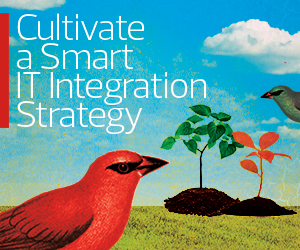Mergers and acquisitions in the healthcare industry have evolved over the past decade as organizations expand outside region-specific limits and look to provide a continuum of care.
As the landscape continues to change, IT integration is no longer a final consideration for a healthcare M&A, after business and clinical priorities, but a core function. As organizations consider M&As to expand patient care capabilities, going from acute care to post-acute and even long-term care offerings, IT integration is an essential part of making everything run.
Though M&As can be a difficult process, organizations don’t have to undergo them alone. By involving a partner early on and having a strong framework in place, organizations can ensure a smoother integration process, especially with regard to cybersecurity. Consider these four questions to guide you in finding the right partner for your healthcare M&A.
Click the banner below to effectively integrate your health IT environment.
1. Which Parts of the M&A Process Should Organizations Target More?
Organizations should spend more time on their people, ensuring everyone understands why an M&A is happening and what the goals are moving forward.
Particularly, there should be more time spent on updated training and career progression incentives rather than dusting off old documentation and procedures.
A team can benefit from new additions, especially when they’re able to train right away. How can you ensure all staff is familiar with existing and incoming technologies? How can you incorporate M&A-specific training programs? It’s an opportunity to recognize different capabilities and to adapt accordingly when acquiring new technologies and talent.
2. How Can a Partnership Help an M&A Process?
Involving an IT partner with knowledge and experience specifically in healthcare M&As can help organizations meet the demand for scale, especially with larger M&As. An expert partner, for instance, understands that thousands of endpoints are involved in clinical operations. Those endpoints are not limited to a single workstation but include any patient-facing device. A partner can help an organization identify all those endpoints and the versions of connected operating systems, and identify any vulnerabilities that may be breached, as part of a migration plan and security infrastructure assessment.
From our experience, for instance, we have industry-specific runbooks and playbooks that showcase CDW’s depth of knowledge in this sector. When a healthcare system reaches out to let us know about an upcoming acquisition, we can help with due diligence and scale on their behalf.
EXPLORE: Why planning is key to managing health IT integration during an M&A.
Because of CDW’s expertise, we’re mindful of healthcare-specific aspects such as the revenue cycle and clinical workflows. We know how to work with conversions of data and electronic medical records systems, how to manage identity migration, and how to minimize impacts to business operations and clinical experiences. As a partner, we take the time to understand the culture of a healthcare system and make sure we're removing any operational burdens.
3. When Should a Healthcare Organization Involve an IT Partner?
Ideally, a partner should be involved in the M&A process as early as possible, before a public merger announcement. But coming in right after an announcement can also work. From our experience, we’ve been involved at the preplanning phase alongside health systems.
A partner that is brought in early on understands the business and IT integration objectives from the beginning, has an easier time helping with integration and can do a lot of the heavy lifting. A partner that is in place before day zero can perform unbiased assessments sooner and make sure security is central.
Click the banner below to learn IT integration best practices during a merger or acquisition.
4. What Is the Top Advice for Security?
Having a plan is critical. You may not always stick to it, but having that framework in place is key so that you have a base to work from when surprises inevitably show up.
For first-time acquisitions, keep an open mind about the security capabilities of each organization. Perhaps the organization being acquired has better security processes, solutions and partnerships that should be adopted overall.
DISCOVER: Tips from CIOs on navigating mergers and acquisitions in healthcare.
The lesson we’ve learned over and over again in the healthcare M&A space is that organizations won’t always know everything they’re going to inherit, especially when it comes to security. There will be surprises that show up on day one and possibly even six months into an integration. Have a day zero plan for the initial assessment of security posture and capabilities, including assessment of any managed services or security operations centers.
Looking Ahead at Future M&As
Healthcare M&As won’t be going away, especially as traditional providers compete with big-tech companies looking to expand. And in the face of staffing shortages and consumerization trends, clinical automation and data analytics will see continued investments.
As healthcare organizations increasingly rely on the cloud, it will ease the process for M&As because data can be accessed more efficiently when it’s not locked in a central location. Implementation time is shrinking as less is spent on buying on-premises hardware to standardize. Capital expenditure will decrease as departments budget more for operating expenses that are easier and more predictable to manage. There will be less infrastructure, fewer contracts and a lot less red tape.
This article is part of HealthTech’s MonITor blog series. Please join the discussion on Twitter by using #WellnessIT.

















